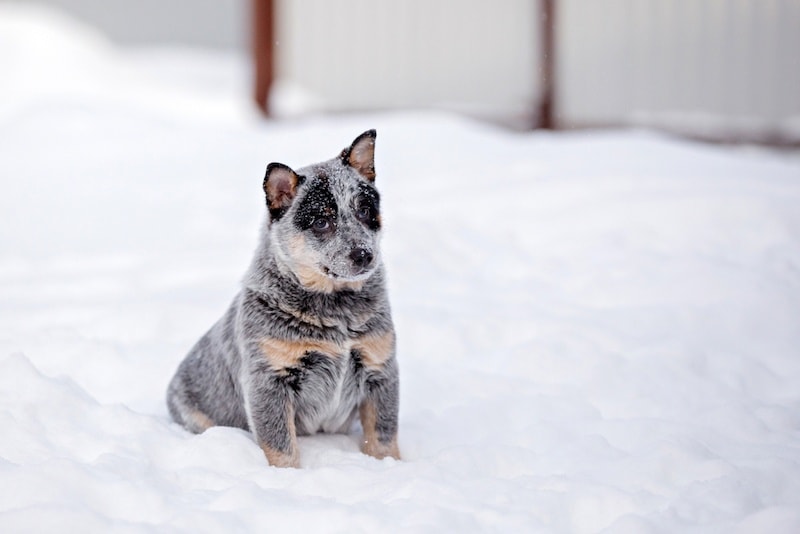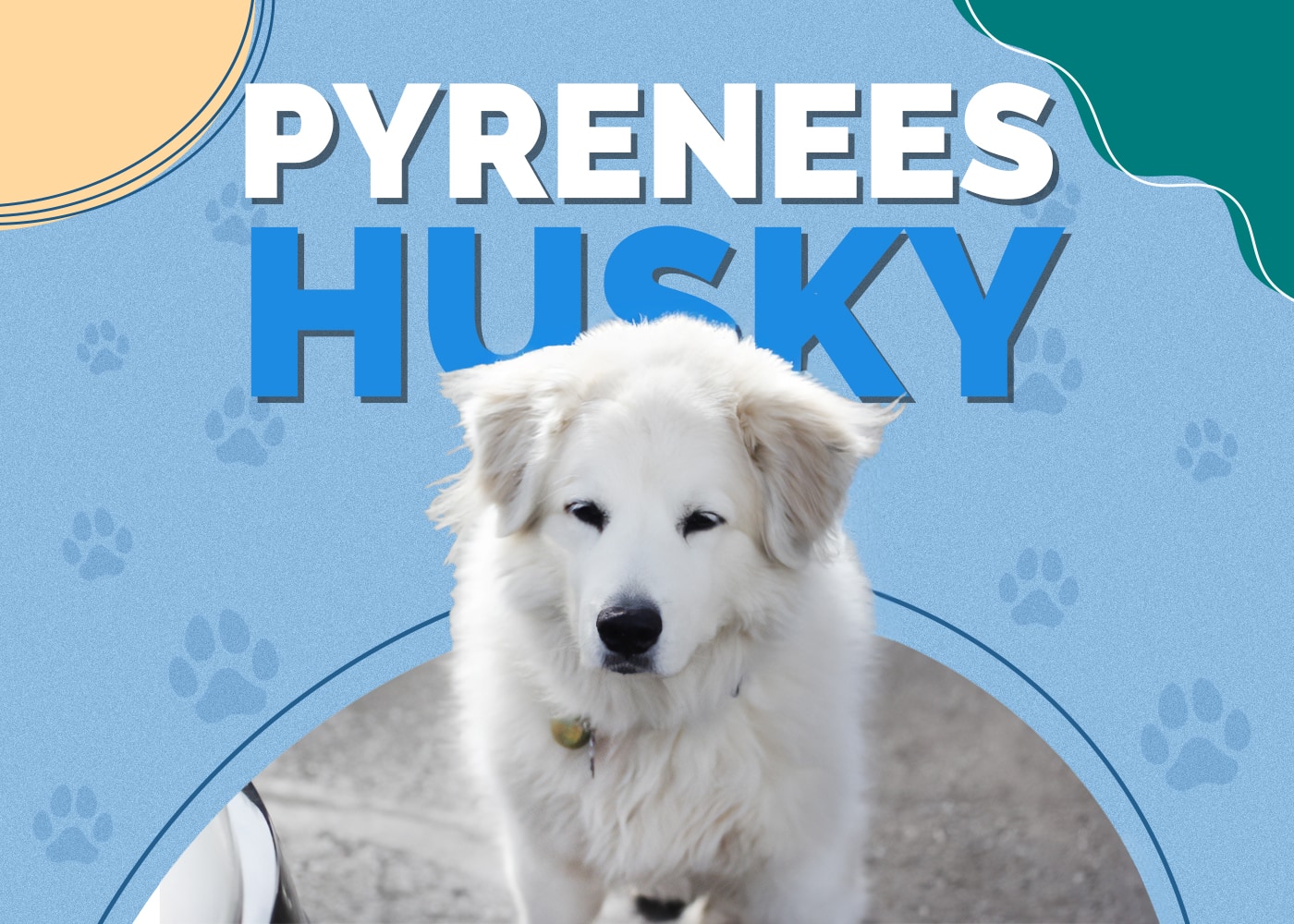Blue-Tzu Heeler (Blue Heeler & Shih-Tzu Mix)

Updated on

| Height: | 10–18 inches |
| Weight: | 10–35 pounds |
| Lifespan: | 10–14 years |
| Colors: | White, blue, black |
| Suitable for: | Active families, or active individuals who work from home, experienced dog owners |
| Temperament: | Protective, Loyal, Affectionate, Stubborn, Playful, Energetic |
There’s no question the Blue-Tzu Heeler is an exciting mix that most people would never conceive of. But someone did, and the result is a protective but playful dog that’s loyal to a fault and as loving as any pet owner could hope for. You’re not alone if you’ve never heard of the Blue-Tzu Heeler. This rare designer breed is pretty new to the scene, so they haven’t had time to become very well-known, but their popularity is growing quickly.
The Blue-Tzu Heeler is a mix between the Blue Heeler, which is an Australian Cattle Dog, and the Shih-Tzu. Surprisingly, it’s a great combination that produces puppies with an adorable look and a loving demeanor.
What results most often is a dog with the face of a Shih-Tzu but the athletic body of a Cattle Dog, albeit in a more compact package. They generally have the coloration of a Blue Heeler and inherit that breed’s protective instincts and desire to please. That’s tempered with the Shih-Tzu’s playful and affectionate personality, which leaves the Blue-Tzu Heeler with a constant desire for their human’s attention.
Blue-Tzu Heeler Puppies – Before You Get One…
https://www.instagram.com/p/COrzkQ4hEvu/?utm_source=ig_web_copy_link
What’s the Price of Blue-Tzu Heeler Puppies?
Because the Blue-Tzu Heeler is such a new breed, there’s a lot of inconsistency in the pricing of the puppies. Both parents are also very popular breeds, so there’s a lot of incentive to continue breeding them as purebreds instead of crossbreeding them. Still, some breeders are producing Blue-Tzu Heelers.
Blue Heelers sell for about $800 to $1,500 from reputable sources. Shih-Tzus are a bit less expensive and cost $500-$1,000. Occasionally, you’ll see Shih-Tzus selling for more, but it’s rare.
Because the pricing of Blue-Tzu Heelers isn’t fully established yet, you can expect to pay anywhere from $500-$1,500 for a puppy. Most of them will fall in the $600-$1,000 range, but some breeders will capitalize on the dog’s rarity and charge a premium.
When purchasing from a breeder, make sure to do your research. Check if the breeder has a good reputation for producing healthy puppies without health concerns. Also, check the conditions of the facility when you get there. Make sure everything is clean and the puppies are well cared for.
Since Blue-Tzu Heelers are a new and somewhat hard-to-find breed, it’s unlikely that you’ll find one up for adoption in a local shelter.
3 Little-Known Facts About the Blue-Tzu Heeler
1. Its Parents Were Bred For Very Different Purposes
Cattle Dogs are working dogs bred for herding cattle, as their name suggests. They’re incredibly intelligent, hard-working, and very athletic. Shih-Tzus are much smaller dogs bred as a companion breed for royalty in Tibet, all the way back in the 17th century. They’ve long been used in dog shows but were never intended as working dogs.
2. They Have A Natural Protective Instinct
Cattle Dogs have a very strong protective instinct. They naturally take on the role of guardian and will fight to protect their family and loved ones. It’s a well-known trait within the breed. Though the Blue-Tzu Heeler may be much smaller, they still tend to be just as naturally protective as their Blue Heeler parents.
They are always alert and will let you know if there’s ever a threat or danger. Your Blue Heeler mix dog won’t take a back seat if such a situation arises. They’ll be right at the front of the pack, ready to fight to protect their family.
3. Blue-Tzu Heelers Are Stubborn Like Their Parents
Blue Heelers and Shih-Tzus may not seem like they have much in common, but they both share one trait—stubbornness. Both breeds are known for their stubborn streak and independence.
A stubborn dog may not seem like such a big deal, but it can make them quite challenging to train. They’re not the best pet for an inexperienced dog owner. They need a firm hand to train them properly, and training is accepted best when started early in the dog’s life.

Temperament & Intelligence of the Blue-Tzu Heeler
Blue-Tzu Heelers are gaining popularity due to their cute looks and loving personalities. They’re very affectionate dogs that crave human interaction. Your Blue-Tzu Heeler won’t want to be left alone for long periods and prefer to accompany you on every outing.
These are also highly intelligent pups that have a strong desire to please. They can learn quickly, though their stubborn streak may sometimes get in the way. Like Cattle Dogs, Blue-Tzu Heelers are full of energy. They rarely run out of playful energy.
Playtime is all the time for these dogs, so be sure that you have plenty of energy of your own to devote to playing with your Blue-Tzu Heeler. They don’t need too much space since they’re pretty small dogs, but they need lots of attention and exercise.
Are These Dogs Good for Families?
Blue-Tzu Heelers make great family pets. They can get along well with every family member and do well with children. Because they love to play so much, having children around to provide constant playmates works well with Blue-Tzu Heelers.
However, they may not get along well with kids who don’t know how to behave with a dog. If the kids tease or otherwise pester your Blue-Tzu Heeler, they won’t be so happy.
Does This Breed Get Along with Other Pets?
Blue-Tzu Heelers usually get along just fine with other pets. They have a natural herding instinct, so it’s not uncommon for them to attempt to herd other pets, and even children!
If your Blue-Tzu Heeler gets more genes from the Cattle Dog side of the family, they could have a pretty strong prey drive, which can make them less agreeable with other, smaller pets. If you socialize your Blue-Tzu Heeler from an early age, you should be able to mitigate this issue and train it out of your dog.
Things to Know When Owning a Blue-Tzu Heeler
Food & Diet Requirements 🦴
Blue-Tzu Heelers are relatively small dogs, topping out at about 35 pounds, and they don’t need too much food. One to 2 cups of high-quality dry dog food each day should suffice.
Like many other smaller dogs, Blue-Tzu Heelers can become overweight if given too much food. They’ll often eat whatever is given, so you’ll want to monitor how much you feed your puppy to ensure you don’t let it get overweight. They are pretty active dogs, so they’ll generally work the food right off, but they can still be prone to overeating if given the opportunity.
Exercise 🐕
This is where the Blue-Tzu Heeler starts to be a bit high-maintenance. They’re very active dogs with plenty of energy. All of that energy needs an outlet, so you’ll need to exercise your Blue-Tzu Heeler quite a lot.
Because they’re smaller dogs, they don’t need huge yards to run around in. However, they need structured play and exercise each day, so 60 minutes of play and exercise should suffice.
Training 🎾
There’s no question that Blue-Tzu Heelers are highly intelligent and can be trained, but they can be stubborn, which can make the process much more difficult.
Because of their stubbornness, a firm hand is needed when training these dogs. It’s best to have dog training experience before attempting to train a Blue-Tzu Heeler.
Grooming ✂️
Shih-Tzus have a coat that’s very similar to hair, and most Blue-Tzu heelers have inherited a similar coat. They are easier on people with allergies, but they’re not hypoallergenic.
This breed does shed, so you’ll want to perform weekly grooming sessions to keep the loose hair and matting to a minimum. Moreover, this will help reduce shedding and keep your Blue-Tzu Heeler’s coat looking healthy.
You’ll also need to do some trimming of the coat around the ears, head, tail, and possibly feet. You can perform this yourself or take your dog to the groomer for an easier time.
Health and Conditions 🏥
Overall, the Blue-Tzu Heeler is a healthy dog, but there are still some health conditions that you should look out for. Cattle Dogs are very hardy and do not have many medical issues, but Shih-Tzus have quite a few common ailments, and some of those may present themselves in your Blue-Tzu Heeler.
Progressive retinal atrophy: Abbreviated as PRA, progressive retinal atrophy is a series of similar eye issues that can plague several breeds. It causes blindness, but slowly. First, you’ll notice that your dog can’t see at night. Then, they’ll also lose the ability to see in the light. There is no cure for PRA, but luckily, it’s not a painful disease.
Hip dysplasia: This condition tends to affect larger dogs the most, but it can be passed down genetically, even in smaller breeds. When a dog has hip dysplasia, their hip is malformed, and the top of their leg bone doesn’t fit in the hip socket properly. This causes the leg bone to rub on the hip uncomfortably, causing pain and limiting movement.
The signs get worse as the dog ages. Unfortunately, there is no way to cure hip dysplasia. With treatment and proper care, you can help minimize the pain, and a dog with this disease can still live a healthy and long life.
Ear infections: Ear infections are a relatively minor issue, but they’re much more common in dogs than humans because of how their ear canals are shaped. As much as 20% of dogs have an ear disease of some type that causes ear infections. Luckily, these are treatable and won’t cause a loss of standard of living for your dog.
- Ear infections
- Progressive retinal atrophy
- Hip dysplasia
Male vs Female
The biggest difference between male and female Blue-Tzu Heelers is their size. Males are larger, and they weigh as much as 35 pounds and reach a maximum height of about 18 inches. Females are a bit smaller. They’re usually 15 inches tall and weigh less than 20 pounds.
Final Thoughts on the Blue-Tzu Heeler
The Blue-Tzu Heeler is a newer breed with very desirable personality traits. They’re incredibly loving and affectionate, loyal to a fault, and naturally protective of their family. Plus, they’re incredibly intelligent, full of energy, and as playful as a pup can be.
They have a good mix of intelligence and loyalty from the working dog side of their lineage and the loving lapdog demeanor of their Shih-Tzu parents. As soon as you meet one, you’ll be convinced of what a remarkable canine they are.
Featured Image Credit: Liliya Fadeeva, Shutterstock















